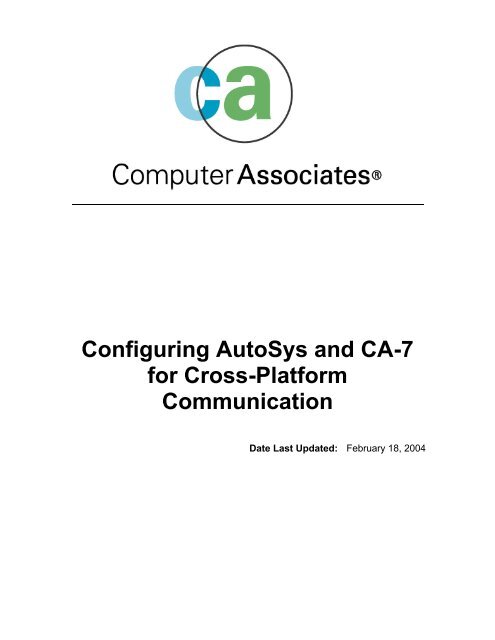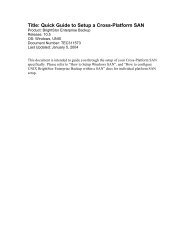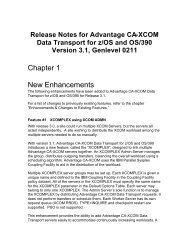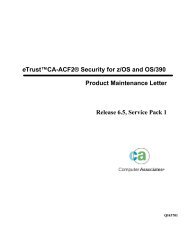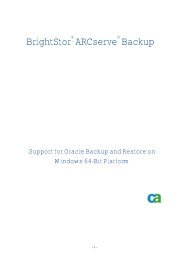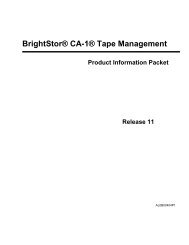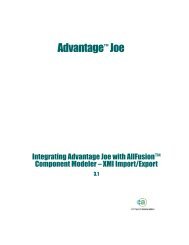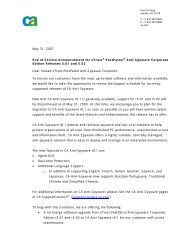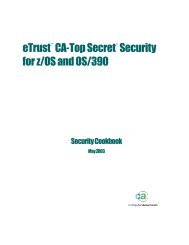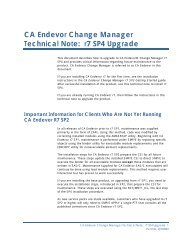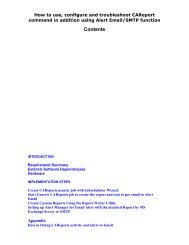Configuring AutoSys and CA-7 for Cross-Platform ... - SupportConnect
Configuring AutoSys and CA-7 for Cross-Platform ... - SupportConnect
Configuring AutoSys and CA-7 for Cross-Platform ... - SupportConnect
You also want an ePaper? Increase the reach of your titles
YUMPU automatically turns print PDFs into web optimized ePapers that Google loves.
<strong>Configuring</strong> <strong>AutoSys</strong> <strong>and</strong> <strong>CA</strong>-7<strong>for</strong> <strong>Cross</strong>-Plat<strong>for</strong>mCommunicationDate Last Updated: February 18, 2004
Page 2<strong>Configuring</strong> <strong>AutoSys</strong> <strong>and</strong> <strong>CA</strong>-7 <strong>for</strong> <strong>Cross</strong>-Plat<strong>for</strong>m CommunicationDescriptionIn today’s IT environment there are many architectural possibilities <strong>for</strong> enterprise <strong>and</strong> nonenterprisescheduling needs. Shops with existing scheduling products may have purchasedmultiple engines based on business, IT, or political needs. Datacenters that are in the process ofpurchasing new or additional scheduling engines are doing this <strong>for</strong> essentially the same reason.This document is intended <strong>for</strong> users already running Unicenter <strong>AutoSys</strong>, Unicenter <strong>CA</strong>-7, <strong>and</strong>/orconsidering a purchase of either tool with the intention of running either of the products in peerto-peermanager scenario. This scope of this document is to provide a cookbook approach onhow to configure <strong>AutoSys</strong> <strong>and</strong> <strong>CA</strong>-7 to work together. It assumes that the user has alreadyinstalled the products mentioned within this document in their environment <strong>and</strong> confirmed via<strong>SupportConnect</strong> or Technical Support that they are running the minimum release levels <strong>and</strong>applicable patches needed to support the configuration. The <strong>CA</strong> Unicenter scheduling engines<strong>and</strong> options that will be discussed in this document are:‣ <strong>AutoSys</strong> – Industry leader distributed scheduling tool. The <strong>AutoSys</strong> server software canbe installed on either UNIX or Windows plat<strong>for</strong>ms. Lightweight <strong>AutoSys</strong> agents <strong>and</strong> ERPadapters allow <strong>AutoSys</strong> to connect, schedule, <strong>and</strong> monitor to any number of differentdistributed <strong>and</strong> mid-range plat<strong>for</strong>ms along with ERP applications such as SAP, PeopleSoftor Oracle Financials.‣ <strong>CA</strong>-7 - Industry leader mainframe scheduling engine. <strong>CA</strong>-7 not only h<strong>and</strong>les themainframe environments but it also has agent capabilities that allow it to extend todistributed <strong>and</strong> mid-range plat<strong>for</strong>ms along with ERP applications.‣ <strong>AutoSys</strong> Connect – Optional product that allows <strong>AutoSys</strong> to converse directly with the<strong>CA</strong>-7 instance to allow seamless dependency posting between the 2 engines. <strong>AutoSys</strong>Connect can also be used against other mainframe scheduling engines in a similarcapacity.In addition Unicenter Enterprise Job Manager is <strong>CA</strong>’s new Java based User Interface thatallows a single ‘pane of glass’ view to manage <strong>and</strong> monitor both <strong>AutoSys</strong> <strong>and</strong> <strong>CA</strong>-7 instances.This is of tremendous benefit to scheduling administrators, management, <strong>and</strong> end-users. Foradministrators it allows ease of use an overall control by having a centralized view over thescheduling environment. Management <strong>and</strong> End-users can monitor mission critical workflow fromthe centralized view <strong>and</strong> be alerted <strong>for</strong> exception conditions. In addition, <strong>AutoSys</strong> Connect willalso be discussed <strong>for</strong> those sites that currently own or are considering purchasing <strong>AutoSys</strong>Connect to work with <strong>CA</strong>-7 or possibly other 3 rd party engines. This document is a livingdocument, which implies that periodic updates may be made. This document should be used asa supplement to the other documentation <strong>for</strong> the cross plat<strong>for</strong>m configuration.Page 2 of 22
Page 3ArchitectureDeciding how the architecture should be implemented is based on many site-specific factors.Consideration should be given to the following areas:‣ Workload architecture to support the business direction‣ Workload configuration to support IT structure or Line of Business requirements‣ Political correctnessTo ultimately determine what scheduling architecture is correct <strong>for</strong> your site please contact yourlocal <strong>CA</strong> representative. They can assist in engaging the correct resources to help you puttogether a vision to ensure job management success. The Computer Associates UnicenterEnterprise Job Management solutions offer a full complement of features necessary to managecross-system workload <strong>and</strong> dependencies.Example 1: High-level cross plat<strong>for</strong>m scheduling architecture using <strong>CA</strong>-7, <strong>AutoSys</strong>, <strong>and</strong> possibly<strong>AutoSys</strong> Connect to different plat<strong>for</strong>ms. The <strong>AutoSys</strong> server could also run on Windows if sodesired.<strong>AutoSys</strong>The Connect Enterprise-based on architecture of today’s IT business environment requires thatmanyz/OS,disparate systems participate in the sharing <strong>and</strong> maintenance of in<strong>for</strong>mation.OS/390This results in many types of dependencies such as files, file updates <strong>and</strong> transfers,task execution, <strong>and</strong> event notification. The Computer Associates Unicenter EnterpriseJob Management solutions offer a full complement of features necessary to managethese cross-system dependencies. This document provides some guidelines <strong>for</strong>planning, implementing, <strong>and</strong> maintaining your cross plat<strong>for</strong>m job managementenvironment. This best practice document is a living document, which implies thatperiodic updates may be made. This document should be used as a supplement tothe other documentation <strong>for</strong> the cross plat<strong>for</strong>m agents. It is targeted to individualsplanning <strong>and</strong> implementing a distributed scheduling environment.UniversalScheduling AgentonAS/400<strong>CA</strong> – 7onz/OS, OS/390<strong>Cross</strong> Plat<strong>for</strong>m communicationsuses CCI (IP) between plat<strong>for</strong>msUniversal Adapter <strong>for</strong>SAPArchitecture<strong>AutoSys</strong> ServeronUnixUniversalSchedulingAgent <strong>for</strong>WindowsThe cross plat<strong>for</strong>m agent is a lightweight application, which is installed on distributedPage 3 of 22
Page 5<strong>Configuring</strong> the EnvironmentIn this section we will focus on installing, implementing, configuring each of the products <strong>and</strong>components to ensure success. Prior to beginning the configuration it is important to check tomake sure you have the required levels, applicable patches, <strong>and</strong> a valid license key <strong>for</strong> the newplat<strong>for</strong>m. Current product <strong>and</strong> service pack levels are listed below. <strong>SupportConnect</strong> <strong>and</strong>/orTechnical Support should be contacted to validate that there are no HYPER patches/PTFs thatshould be applied. For license keys there are differences between <strong>AutoSys</strong> 4.5 <strong>and</strong> previous<strong>AutoSys</strong> releases in how license keys are implemented. Contacting either the <strong>CA</strong> Licensing groupor <strong>AutoSys</strong> Technical Support <strong>for</strong> help will answer any questions. For additional in<strong>for</strong>mation inreference to specific product questions please refer to your product installation manuals orcontact Technical Support. The products discussed in this document <strong>and</strong> current supported levels<strong>for</strong> this section will be:ProductCurrent Supported Levels<strong>AutoSys</strong> 4.5, 4.0<strong>CA</strong>-7 3.3<strong>CA</strong> Common Services 3.0, 2.2<strong>AutoSys</strong> Connect (optional) 2.4.1Page 5 of 22
Page 8CCI name = A logical name <strong>CA</strong>-7 Agent may use to insulate itself from the network <strong>and</strong>any protocols being used. The default is the host name. For the REMOTE statementthat defines the mainframe, the <strong>CA</strong>ICCI name is the value specified by SYSID (xxxx)which by default is defined in the CCIPARM member on the //ENFPARMS DD statementin the ENF proc. The ENF joblog can also be used to determine the SYSID by checkingthe startup options displayed.STARTUP = if specified, the connection is attempted as soon as <strong>CA</strong>ICCI starts. This isrecommended.PORT = specifies the TCP/IP port number to use. The default is 1721, which is thedefault port <strong>for</strong> Unicenter TNG <strong>and</strong> <strong>CA</strong>-7 Agent. This value must match the value definedon the PROTOCOL(TCPIPGW....) statement.ALIAS = is only valid on the LO<strong>CA</strong>L statement. If the "cciname" is longer than eightcharacters, a one- to eight-character alias must be used to accommodate <strong>CA</strong>ICCI on themainframe. The mainframe will truncate the name to the first 8 characters if an alias isnot provided. This may cause problems if the machines have similar names.RETRY = is only valid on the REMOTE statement. If the connection cannot be made oris broken, <strong>CA</strong>ICCI will retry the connection every n minutes.3) On a Unix machine the asbIII process communicates to the <strong>AutoSys</strong>, Universal JobManagement agents, <strong>and</strong> mainframe machines using CCI. You need to configure CCI tocommunicate with a particular machine. For this to work you will not only have to updatethe ccirmtd.prf file you will also have to ensure that the cciccid.prf <strong>and</strong> thecciclnd.prf files have been created. Following is a breakdown of what these two files are<strong>for</strong>:caiccid.prfInstructs the main <strong>CA</strong>ICCI demons what to do <strong>and</strong> specifies the Max_Recvrs value. Thecaiccid.prf file is found in the following location:$<strong>CA</strong>IGLBL0000/cci/config//caiccid.prfNodename = Identifies the machine on which the Enterprise Management <strong>CA</strong>ICCIdemons are running. The following is an example of the caiccid.prf file:CLN_Demon = cciclnd startupRMT_Demon = ccirmtd startupMax_Recvrs = 48,32The following parameters specify what the <strong>CA</strong>ICCI demons are to do <strong>and</strong> specify theMax_Recvrs parameter:CLN_Demon = cciclnd startup - This setting instructs CCI to start the CCI cle<strong>and</strong>emon when you start CCI.RMT_Demon = ccirmtd startup - This setting instructs CCI to start the CCI remotedemon when you start CCI.Page 8 of 22
Page 9Max_Recvrs = nn, mm - Value of nn defines the number of CCI receivers which alsodetermines the size of the shared memory segment <strong>for</strong> RVT lists. The value of mm is thenumber of messages that CCI will queue up. These parameter values are explained inthe Shared Memory <strong>for</strong> RVTs section of the in the Unicenter <strong>AutoSys</strong> JobManagement <strong>for</strong> Unix Installation Guide. Note: We do not recommend that youupdate the cciccid.prf configuration file unless the file hits the Max_Recvrs limit.cciclnd.prfDefines the number of seconds to sleep between system scans <strong>for</strong> communicationsbuffer <strong>and</strong> connections cleaning. The default time value <strong>for</strong> cciclnd is one second. Thedefault value should not be changed unless instructed by Computer AssociatesTechnical Support. The cciclnd.pr file is found in the following location:$<strong>CA</strong>IGLBL0000/cci/config//cciclnd.prfNodename = Identifies the machine on which the <strong>CA</strong>ICCI demons are running.All three of these files are explained in greater detail in the Unicenter <strong>AutoSys</strong> JobManagement Installation guides <strong>for</strong> Windows <strong>and</strong> UNIX.4) <strong>CA</strong>ICCI must be restarted to pick up changes to the CCIRMTD file. To Start/Stop CCI onWindows or Unix you can use the following comm<strong>and</strong>sStart CCI on Windows:If Unicenter is installed: unicntrl start uniIf Unicenter is not installed: ccicntrl startStop CCI on Windows:If Unicenter is installed: unicntrl stop uniIf Unicenter is not installed: ccicntrl stopStart CCI on UNIX:If Unicenter is installed: unistart cciIf Unicenter is not installed: $<strong>CA</strong>IGLBL0000/cci/scripts/CCISA_rcStop CCI on UNIX:If Unicenter is installed: unishutdown cciIf Unicenter is not installed: $<strong>CA</strong>IGLBL0000/cci/scripts/CCISA_cshutDefining the Mainframe Host to <strong>AutoSys</strong> without <strong>AutoSys</strong> ConnectTo define the mainframe host to <strong>AutoSys</strong> database you can use jil to add the machine name<strong>and</strong> type. From the OS comm<strong>and</strong> prompt enter:1) jil2) insert_machine: remote_host - where remote_host is the CCINAME as defined inthe CCIPARM member called by the ENFPARMS DD stmt in the TCPIP gateway procon the mainframe. Further explanation on the mainframe CCI/ENF parameters isdescribed later in this document.3) type: t = “t” implies Unicenter <strong>AutoSys</strong> Job Management will submit work directly to<strong>CA</strong>7.Page 9 of 22
Page 10To find out what the remote_host name is defined to in CCI, per<strong>for</strong>m the following comm<strong>and</strong> atthe comm<strong>and</strong> prompt:1. ccii – following is a sample of the output from this task:Oid(XE21,<strong>CA</strong>-7 XTM UC07 ) Did( , ) type(R)Oid(XE21,SYS54 ) Did( , ) type(R)Oid(XE21,S9TR ) Did( , ) type(R)Oid(XE21,EMSRVC_ROUTER_U ) Did( , ) type(R)Oid(XE21,ROUTER_SERVER ) Did( , ) type(R)Oid(XE21,S9CICICSADG3CICSADG3) Did( , ) type(R)Oid(XE21,JOBTRAC Server ) Did( , ) type(R)Oid(XE21,JOBTRAC Job track ) Did( , ) type(R)Oid(XE21,<strong>CA</strong>U9SET SetUp Mgr ) Did( , ) type(R)Oid(XE21,SUBMITC Server ) Did( , ) type(R)Look <strong>for</strong> the SUBMITC Server <strong>and</strong> just to the left of this is theCCINAME(remote_host) that you would use.Page 10 of 22
Page 11Adding the <strong>AutoSys</strong> Superusers, Userids, <strong>and</strong> PasswordsWhen an <strong>AutoSys</strong> remote agent runs a job, it logs on to the remote machine as the owner of thejob. To accomplish this, the remote agent uses the encrypted passwords that were passed to itwith the job request by the event processor. The event processor gets these passwords from theevent server (database). There<strong>for</strong>e, after the installation is complete <strong>and</strong> be<strong>for</strong>e you can run<strong>AutoSys</strong> jobs, you must enter the IDs <strong>and</strong> passwords <strong>for</strong> users who will define <strong>and</strong> run jobs.Be<strong>for</strong>e you can enter the user IDs <strong>and</strong> passwords in the <strong>AutoSys</strong> database, you must firstestablish the <strong>AutoSys</strong> edit superuser. This user is a special user to <strong>AutoSys</strong> with Administratorlikeprivileges. The edit superuser has read <strong>and</strong> write permissions to the <strong>AutoSys</strong> database.Only the <strong>AutoSys</strong> edit superuser can add <strong>AutoSys</strong> user passwords, using the <strong>AutoSys</strong> secureutility; however, after user IDs <strong>and</strong> passwords exist in the database, any user who knows apassword can use <strong>AutoSys</strong>_secure to change that password or delete that user definition. At thistime, you should also enter the <strong>AutoSys</strong> exec superuser, who can issue comm<strong>and</strong>s <strong>and</strong> stopthe event processor.Note: If you are upgrading, the edit superuser definition was maintained when you upgradedyour database.Defining the <strong>AutoSys</strong> edit superuser <strong>and</strong> exec superusers:1. Open an <strong>AutoSys</strong> instance comm<strong>and</strong> prompt window from your <strong>AutoSys</strong> program2. Enter the following at the comm<strong>and</strong> prompt - <strong>AutoSys</strong>_secure3. When you run <strong>AutoSys</strong>_secure, a menu is displayed, <strong>and</strong> you should select thefollowing item by entering 1: [1] Change <strong>AutoSys</strong> EDIT <strong>and</strong> EXEC superusers.4. When prompted, enter the <strong>AutoSys</strong> edit superuser logon name <strong>and</strong> the execsuperuser logon name. These users must be valid users on the machine or domain thatyou are logged on to.Note: Be sure to run all <strong>AutoSys</strong> comm<strong>and</strong>s at an <strong>AutoSys</strong> instance comm<strong>and</strong> prompt,which is located in the <strong>AutoSys</strong> program group. The <strong>AutoSys</strong> instance comm<strong>and</strong> promptwindows set several environment variables that are needed to run <strong>AutoSys</strong> comm<strong>and</strong>s.Page 11 of 22
Page 12Be<strong>for</strong>e you can fully utilize <strong>AutoSys</strong>, you must enter the user IDs <strong>and</strong> passwords <strong>for</strong> all users onall domains that will define <strong>and</strong> run jobs. The user ID must be a valid user on the machine onwhich you will process the job. The user password is the same as the user’s password they useto sign on to the machine. To add a Windows user ID <strong>and</strong> password to the <strong>AutoSys</strong> database:Defining users associated with creating <strong>and</strong> running jobs:1. Log on to Windows as the user you have established as the <strong>AutoSys</strong> edit superuser.2. Open an <strong>AutoSys</strong> instance comm<strong>and</strong> prompt window from your <strong>AutoSys</strong> program group.Enter the following at the comm<strong>and</strong> prompt: - <strong>AutoSys</strong>_secure3. When you run <strong>AutoSys</strong>_secure a menu is displayed with options to add <strong>and</strong> changeusers <strong>and</strong> passwords.4. Select the following menu option by entering 4: [4] Create <strong>AutoSys</strong> User@Host orDomain password5. At the prompt, enter the user name, host or domain name, password, <strong>and</strong> passwordconfirmation. If the user is created successfully, the user in<strong>for</strong>mation is entered into the<strong>AutoSys</strong> database with the encrypted password. Windows user IDs must not exceed 20characters, <strong>and</strong> they can include any characters except the following: (" / ; : < > |= + * …An example of a user would look like this: administrator@localhostNote: Windows passwords must not exceed 14 characters, <strong>and</strong> they can contain anycharacter except a space. In addition, they are case-sensitive <strong>and</strong> must be at least 5characters in length. For more in<strong>for</strong>mation on creating, changing, <strong>and</strong> deleting user IDs<strong>and</strong> passwords, see <strong>AutoSys</strong>_secure in the chapter “<strong>AutoSys</strong> Comm<strong>and</strong>s” in theUnicenter <strong>AutoSys</strong> Job Management <strong>for</strong> Windows <strong>and</strong> UNIX Reference Guide.Page 12 of 22
Page 13Adding a Job to <strong>AutoSys</strong> that will Run on <strong>CA</strong>-7In order <strong>for</strong> Unicenter <strong>AutoSys</strong> Job Management to submit a using <strong>CA</strong>-7 the job must be definedas a valid job within <strong>CA</strong>-7. The job to be executed is specified within the <strong>AutoSys</strong> job definition.Conversely, in order <strong>for</strong> <strong>CA</strong>-7 to submit a job to <strong>AutoSys</strong> the job to be executed (specified by theSUBFILE parameter of the <strong>CA</strong>-7 job) must be defined as a valid job within the Unicenter <strong>AutoSys</strong>Job Management system. This section will help you set-up a job in <strong>AutoSys</strong> that will run under<strong>CA</strong>-7. The job type is a comm<strong>and</strong> job that can be defined to be dependent on certain startingconditions to instruct <strong>AutoSys</strong> when <strong>and</strong> where to run the job. To submit a job directly to <strong>CA</strong>7where the <strong>CA</strong>7 defined job to run on the mainframe is named “ <strong>CA</strong>7JOBNM “ use the followingjil from the OS comm<strong>and</strong> prompt:1. jil2. insert_job: anyjobname3. comm<strong>and</strong>: <strong>CA</strong>7JOBNM4. machine: cciname5. permissions: gx,wx,mx6. owner:user@SMFIDNote 1: There are 3 optional keywords that can be used on the “comm<strong>and</strong>” statement. Theyare XPSCHD, SCHID, <strong>and</strong> MONITOR. Brief descriptions of these comm<strong>and</strong>s are listed belowbut a more in-depth explanation can be found in the <strong>CA</strong>-7 section of this document under Step2 of “<strong>Configuring</strong> <strong>CA</strong>-7 <strong>for</strong> Bi-Directional Scheduling with <strong>AutoSys</strong>”.Example of the comm<strong>and</strong> statement:comm<strong>and</strong>: <strong>CA</strong>7JOBNM ,MONITOR=monitorname, XPSSCHD=xxxxxx, SCHID=XXXMonitor=monitornameAs defined in the SVCNO parm in the <strong>CA</strong>-7 Init file. This identifies the <strong>CA</strong>-7 instance that you willpointing to <strong>and</strong> is usually only required if you are executing more then a single <strong>CA</strong>-7 instance.XPSSCHD=xxxxxxxxDepending on the value of the XPSSCHD parameter in your <strong>CA</strong>-7 Init File you can state whichmethod (Dem<strong>and</strong> or Run) should be used when bringing a job into <strong>CA</strong>-7SCHID=xxxxxxThis parameter can be used to <strong>for</strong>ce <strong>CA</strong>-7 to bring in a job with a specific SCHID value. If not,the default schid of 000 will be used.Page 13 of 22
Page 14<strong>CA</strong>-7Configuration of Mainframe Common ServicesNote: A recycle of <strong>CA</strong>-7 <strong>and</strong> ENF will be required to pick up changes as implementedin the next 2 sections. You do not need to recycle either product until Step 11 of‘<strong>Configuring</strong> <strong>CA</strong>-7 <strong>for</strong> Bi-Directional Scheduling with <strong>AutoSys</strong>).1. When configuring Common Services it is a good idea be<strong>for</strong>eh<strong>and</strong> to double check yourrelease <strong>and</strong> patch levels of the mainframe Common Services (<strong>for</strong>merly <strong>CA</strong>90’s) <strong>and</strong> tocontact <strong>CA</strong> Technical Support <strong>for</strong> any HYPERS or recommended PTFs. Optimally yourrelease level should be current, but try not to use anything lower than 2.2 SP1 +required patches that can be obtained via <strong>SupportConnect</strong> or Technical Support. Todetermine the level of <strong>CA</strong>90’s you can check in the output of the <strong>CA</strong>IENF started task <strong>for</strong>message <strong>CA</strong>S9075I.2. Validate the type of TCP/IP that you are using. The type of TCP/IP used will dictate thegateway proc, CCI proc, <strong>and</strong> Common Services FMIDs to be installed. The following arethe various types:‣ TCPIPGW: Peer to peer support <strong>for</strong> IBM TCP/IP using LE/MVS runtime.‣ TCPIP3GW: Peer to peer support <strong>for</strong> TCPAccess TCP/IP versions 3.1 <strong>and</strong> 4.1.‣ TCPIPSGW: Peer to peer support <strong>for</strong> IBM TCP/IP using SAS/C runtime in placeof IBM's LE.3. Ensure that all of required Common Services FMIDs are installed. Below is a list of theseFMIDs. If any FMIDs required are currently not installed please install them be<strong>for</strong>econtinuing. Refer to the Common Services Installation <strong>and</strong> Maintenance Guide <strong>for</strong>instructions.FMIDCS91000CW11000CW21000CW41100Common Services Product Name <strong>and</strong> Description<strong>CA</strong>IRIM – <strong>CA</strong> Resource Initialization Manager<strong>CA</strong>IENF – <strong>CA</strong> Event Notification Facility<strong>CA</strong>ICCI – <strong>CA</strong> Common Communications InterfaceCF33100 <strong>CA</strong>-C Runtime 3.1 – <strong>CA</strong> C Language Runtime Facility Release 3.1Important Note be<strong>for</strong>e Proceeding:Steps 4-5 below are only required if you are using proc CCITCPGW <strong>and</strong> the programexecuted <strong>CA</strong>S9CTPM, commonly known as the “C version” as it is written in the Clanguage. The other program that may be executed is <strong>CA</strong>S9ATPM <strong>and</strong> does not requirethese steps.4. Make sure IBM fix PTF UQ43223 (APAR PQ38033) has been applied <strong>and</strong> activated. Itis packaged in with OS/390 release 2.10 but it is important that the TCPIP re-entrantlibraries have been rebuilt. This is done by running the EDCLIB proc substituting thefollowing exec statements <strong>for</strong> the existing //EXEC statement: (run this process once <strong>for</strong>each exec statement)Page 14 of 22
Page 15// EXEC EDCLIB,LIBRARY=’TCPIP.SEZARNT1’,OPARM=’DIR’// EXEC EDCLIB,LIBRARY=’TCPIP.SEZARNT4’,OPARM=’DIR’// EXEC EDCLIB,LIBRARY=’TCPIP.SEZAROE1’,OPARM=’DIR’// EXEC EDCLIB,LIBRARY=’TCPIP.SEZAROE4’,OPARM=’DIR’Note: For any release of OS390 below 2.9., the APAR must be applied <strong>and</strong> the aboveproc processed substituting the above EXEC statements to rebuild the TCP/IP re-entrantlibraries5. Once the FMIDs, <strong>and</strong> if necessary the IBM APAR mentioned in #4 is linked, submit jobW010LINK from <strong>CA</strong> Common Services sample JCL library. This job will build the CCIGateway load module required <strong>for</strong> cross-plat<strong>for</strong>m communication.6. Update the proper TCP/IP proc to be used as the gateway to site st<strong>and</strong>ards. Theprocedures containing the JCL needed to set-up the TCP/IP gateway are normally foundin the <strong>CA</strong> Common Services <strong>CA</strong>IPROC library as CCITCPGW.7. Update the ENFPARMS DD statement to point to the CCIPARM member that will executethe proper TCP/IP gateway proc. The in<strong>for</strong>mation contained in the CCIPARM member willinclude a SYSID <strong>and</strong> a Protocol statement as defined below:SYSID(cciname)cciname is the name that <strong>CA</strong>ICCI will use <strong>for</strong> this node. This value is a unique name <strong>and</strong>usually is the same as the LPAR. It can be any unique name up to 8 characters long.PROTOCOL(TCPIPGW)TCPIPGW – Peer-to-peer support <strong>for</strong> IBM TCP/IP using LE/MVS runtime.Proc: CCITCPGW.Note: Other parameters, such as the port address may be required to be added to thePROTOCOL statement. This would depend on whether the site used installation defaultsor modified proc names.8. Update the proc to con<strong>for</strong>m to site st<strong>and</strong>ards <strong>and</strong> copy to a system proclib.9. Start or Restart <strong>CA</strong>IENF to have changes take effect. If ENF cannot be recycled a modifycomm<strong>and</strong> “F ENF,PROTOCOL(TCPIPGW,7000)” may be issued to start the gatewayproc. The 7000 is the port number <strong>for</strong> the proc to use <strong>and</strong> can be changed to sitest<strong>and</strong>ards.10.Note: After restarting ENF, the TCPIP gateway proc will execute. If this proc abendswith a SOC4 verify that the above-mentioned IBM PTF(UQ43223) has been applied<strong>and</strong> the TCPIP re-entrant libraries rebuilt as mentioned.Page 15 of 22
Page 16<strong>Configuring</strong> <strong>CA</strong>-7 <strong>for</strong> Bi-Directional Scheduling with <strong>AutoSys</strong>1. Define the <strong>CA</strong>IENF <strong>Cross</strong>-Plat<strong>for</strong>m Scheduling Feedback Event (<strong>CA</strong>XPSFBK). You willneed to update <strong>and</strong> run <strong>CA</strong>-7 SAMPJCL member L2DCM2. This job will define the<strong>CA</strong>XPSFBK <strong>and</strong> <strong>CA</strong>IENF event <strong>and</strong> data elements. This will require a recycle of ENFafter the ENF event is defined (See Step 11).2. Validate the correct cross-plat<strong>for</strong>m scheduling keywords are defined to the SVCNOstatement in the <strong>CA</strong>-7 Initialization File. An example of the SVCNO statement is belowSVCNO, SASSVC=YES, ROUTER=YES,MONITOR=YES,XPSSCHD=RUNREF)MONITOR=YES: This indicates that <strong>CA</strong>-7 XPS SERVER functions should be activated.MONITOR=YES will use <strong>CA</strong>7xxxx (where xxxx is the smfid of the local system) as theMonitor Name. If you would like you can explicitly define the monitor name(MONITOR=<strong>CA</strong>7xxxx) in place of MONITOR=YES. Where xxxx is the smfid or fourunique characters. If you are running multiple <strong>CA</strong>-7’s you will need to explicitly identifythe <strong>CA</strong>-7 being used. The XPS ROUTER will execute on only one copy of <strong>CA</strong>-7 at anygiven <strong>CA</strong>ICCI node. The XPS ROUTER will be started on the production copy of <strong>CA</strong>-7 bydefault if MONITOR=YES is coded. If cross-plat<strong>for</strong>m scheduling is to be used only witha test copy of <strong>CA</strong>-7 then ROUTER=YES must be coded on the SVCNO statement <strong>for</strong> thetest copy in order to start the XPS ROUTER.If the SVCNO parameter in the <strong>CA</strong>-7 initialization file (ONLINE) is set toXPSSCHD=RUNREF you must add the XPSSCHD parameter to the end of thecomm<strong>and</strong> info in <strong>AutoSys</strong>. This will allow the job being submitted by <strong>AutoSys</strong> to act as ifit was a normal dem<strong>and</strong>. If the XPSSCHD keyword on the SVCNO parameter is set toDEMAND the above keyword is not necessary. By adding SCHID=XXX (where xxx =a specific <strong>CA</strong>-7 schid) to the <strong>AutoSys</strong> comm<strong>and</strong> you can request a specific SCHID to beused when bringing the <strong>CA</strong>-7 job in. If no SCHID is used <strong>CA</strong>-7 will bring the job in underSCHID=001 (default SCHID). The XPSSCHD parameter defines how the job behavesunder <strong>CA</strong>-7. By default, cross-plat<strong>for</strong>m jobs enter <strong>CA</strong>-7 using the RUNREF option. Thisassigns the role of scheduling manager to <strong>AutoSys</strong>. The primary responsibility <strong>for</strong>workload control belongs to <strong>AutoSys</strong>. Jobs scheduled using this option will NOT honorrequirements defined in <strong>CA</strong>-7, they will NOT be considered requirements <strong>for</strong> other <strong>CA</strong>-7jobs <strong>and</strong> they will NOT trigger other <strong>CA</strong>-7 jobs at completion. This variant of the RUNcomm<strong>and</strong> differs from the st<strong>and</strong>ard RUN comm<strong>and</strong> in that it will not allow a <strong>CA</strong>-7 restart.A job scheduled using this comm<strong>and</strong> is considered "complete" at either normal orabnormal termination. An entry <strong>for</strong> the job will appear in the <strong>CA</strong>-7 RUNLOG, however noentry is created <strong>for</strong> the job in the prior-run queue.A greater degree of workload control over cross-plat<strong>for</strong>m jobs may be assigned to <strong>CA</strong>-7using the XPSSCHD=DEMAND or XPSSCHD=RUN options. If either of these optionsis used, then additional management functions become the responsibility of <strong>CA</strong>-7.XPSSCHD=RUN confers additional responsibility on <strong>CA</strong>-7 <strong>for</strong> monitoring <strong>and</strong> control ofrestart <strong>and</strong> rerun conditions. However, since the RUN comm<strong>and</strong> is used to schedule thejob, <strong>CA</strong>-7 requirement <strong>and</strong> trigger definitions will be ignored. XPSSCHD=DEMANDconfers even more management responsibility on <strong>CA</strong>-7. Because the DEMAND comm<strong>and</strong>is used to schedule the job, <strong>CA</strong>-7 requirement <strong>and</strong> trigger definitions will be honored, <strong>and</strong>Page 16 of 22
Page 17<strong>CA</strong>-7 must be used to monitor restart <strong>and</strong> rerun conditions. It is recommended thatXPSSCHD=DEMAND be used to provide the extra control.3. You will need to define at least one ARF trailer terminal. This is a DEVICE=TRXDV typeterminal. If you all ready have one defined, you do not have to define another. Here is asample definition, which consist of 4 statements:GROUP,NAME=TRXGRP,DEVICE=TRXDV,LNAME=TRXLN,OPEN=YESLINE,NAME=TRXLN,BUFSIZE=1024,TNAME=TRXT1,OPEN=YESTERM,NAME=TRXT1,DEVICE=TRXDV,NLINE=1,LINLEN=80STATIONS,TRMID=TRXT1,STANIDS=(TRK)Note 1: See <strong>CA</strong>-7 Systems Programmer Guide <strong>for</strong> additional in<strong>for</strong>mation on definingterminals.Note 2: <strong>CA</strong>-7 will need to be recycled <strong>for</strong> the options added in steps 3 <strong>and</strong> 4 (see Step12) to take affect. When <strong>CA</strong>-7 starts up you will see <strong>CA</strong>XPSxxx messages in the joblog.4. If you wish to define cross-plat<strong>for</strong>m scheduling password requirement rules then youmust create a data set or PDS member to hold these rules. Add an XPSPSWD DDstatement to the <strong>CA</strong>-7 JCL where the XPS ROUTER will execute. Review "<strong>Cross</strong>-Plat<strong>for</strong>mServer Password Requirements" in Section 6.3.3 in the Unicenter <strong>CA</strong>-7 InterfacesGuide on coding the password requirement rules. This is optional <strong>and</strong> if you make thischange then a recycle of <strong>CA</strong>-7 will be required (see Step 11)5. Allocate <strong>and</strong> initialize the <strong>CA</strong>-7 XPS Profile PDS. You can complete this by modifying <strong>and</strong>executing member XPSPROF from the <strong>CA</strong>-7 sample JCL library.6. Create member <strong>CA</strong>CCENV in the XPS Profile PDS with the keyword entry specifying theenvironment parameter <strong>for</strong> the submit function. This variable is the Monitor Statement,which must be exactly seven characters. <strong>CA</strong>7PROD should be avoided because UnicenterTNG <strong>and</strong> <strong>CA</strong>-7 commonly use this <strong>for</strong> VAX. A good choice might be <strong>CA</strong>7 followed by theSMF-ID of the originating system. This value must match the one used by the <strong>CA</strong>-7<strong>Cross</strong>-Plat<strong>for</strong>m Tracking System (<strong>CA</strong>7XTRK) as its parm value.7. Allocate the <strong>CA</strong>-7 XTRK Checkpoint files to be used in the <strong>CA</strong>-7 cross-plat<strong>for</strong>m trackingSTC. Update member XPSCKPT in the <strong>CA</strong>-7 Sample JCL library. See “<strong>CA</strong>-7 <strong>Cross</strong>-Plat<strong>for</strong>m Tracking JCL" in section 6.2.2.1 of the <strong>CA</strong>-7 Interfaces Guide <strong>for</strong> morein<strong>for</strong>mation.8. Modify member <strong>CA</strong>7XTRK, in the <strong>CA</strong>-7 sample JCL library, with the seven-character parmvalue defined in the MONITOR statement in member <strong>CA</strong>CCENV that was created in Step6 above. Once this has been completed, move the started task JCL to the site st<strong>and</strong>ardproclib <strong>and</strong> start <strong>CA</strong>-7 cross-plat<strong>for</strong>m tracking task (<strong>CA</strong>7XTRK). <strong>CA</strong>7XTRK can be also runas a subtask under ICOM. See “<strong>CA</strong>-7 <strong>Cross</strong>-Plat<strong>for</strong>m Tracking JCL" in section6.2.2.1 of the <strong>CA</strong>-7 Interfaces Guide <strong>for</strong> more in<strong>for</strong>mation.9. Modify member <strong>CA</strong>7TOUNI in the <strong>CA</strong>-7 sample JCL library to define the <strong>CA</strong>-Driverprocedure <strong>for</strong> the <strong>CA</strong>-7 XPS submit function. This proc will enable submission of a <strong>CA</strong>-7batch job that will execute program <strong>CA</strong>7TOUNI to send execution data through <strong>CA</strong>ICCI toPage 17 of 22
Page 18the XPS SERVER on the target plat<strong>for</strong>m. The XPS SERVER on that plat<strong>for</strong>m in turnsubmits the job <strong>and</strong> returns <strong>CA</strong>IENF tracking data as it executes. Any output from the jobwill be directed to the XPS SERVER console on that plat<strong>for</strong>m. The PROFILE DD mustreference the XPS Profile Dataset defined in step 5.10. Allocate a <strong>CA</strong>-7 Driver proc <strong>and</strong> add a <strong>CA</strong>RPROC DD statement to the <strong>CA</strong>-7 Online task.Copy member <strong>CA</strong>7TOUNI into this driver proc. <strong>CA</strong>-7 must be restarted <strong>for</strong> changes totake effect (see Step 11) . If you are not familiar with <strong>CA</strong>-Driver, see "<strong>CA</strong>-DriverProcedures, Variable Parameters, <strong>and</strong> Functions" in Section 4.0 of the <strong>CA</strong>-7Interfaces Guide.11. Recycle <strong>CA</strong>-7 at this time to allow <strong>for</strong> all <strong>CA</strong>-7 changes to take effect12. Define the <strong>CA</strong>-7 cross-plat<strong>for</strong>m jobs <strong>and</strong> JCL <strong>for</strong> the submit function. You can usemember <strong>CA</strong>7XSUB as a guide. The jobs should be defined <strong>and</strong> scheduled like any other<strong>CA</strong>-7 job, only the JCL is different. There are multiple parameters that can be definedwithin the SYSIN DD of the cross plat<strong>for</strong>m job. The two required parms are the NODE<strong>and</strong> the SUBFILE parameters that identify the destination where the job will besubmitted <strong>and</strong> the job name that will be run in AUTOSYS. There maybe other optionalparameters that might be applicable to your environment. Review the SubmitFunction section of the <strong>CA</strong>-7 Interfaces Guide. An example of the JCL is as follows:#7UNI//<strong>CA</strong>7TEST1 JOB ...jobcard...values...//STEP1 EXEC <strong>CA</strong>7TOUNI (execute <strong>CA</strong>-Driver proc)//SYSIN DD *NODE=ccinameSUBFILE=jobname/*Note 1: The jobname is case sensitive. For more in<strong>for</strong>mation see “<strong>CA</strong>-7 <strong>Cross</strong>-Plat<strong>for</strong>m Tracking JCL" in Section 6.2.2.1 of the <strong>CA</strong>-7 Interfaces Guide <strong>for</strong> morein<strong>for</strong>mation.Page 18 of 22
Page 19<strong>AutoSys</strong> Connect (optional)The benefit of having <strong>AutoSys</strong> Connect is that job/event dependencies associated with <strong>CA</strong>-7submitted jobs can be automatically tracked <strong>and</strong> real-time posted without requiring an additional<strong>AutoSys</strong> job to be defined <strong>and</strong> executed to initiate a <strong>CA</strong>-7 job.<strong>AutoSys</strong> Connect FeaturesXCCODEOne of the benefits of using <strong>AutoSys</strong> Connect is to allow <strong>for</strong> the return of true job status. Forexample, a job running on a distributed machine is believed to be a failed job unless it returns acode of 0. With <strong>AutoSys</strong> we can customize the job stream through exit codes of certain jobs <strong>and</strong>allow the job stream to continue processing. Consider the following scenario:You want <strong>AutoSys</strong> as_jobB to process on the success condition of ca7_jobA however, <strong>CA</strong>7JOBAdoes not simply return 0 as a return code. Within the JCL of this job there are multiple job steps,<strong>and</strong> we can define through the XCCODE member on which job steps we would like Connect toreturn failure back to <strong>AutoSys</strong>.<strong>CA</strong>7JOBAas_jobBca7_jobA ends on step PAYROLL with a return code of 4. According to this particular ca7 job, thejob finishes successfully but with a warning however, on the distributed side, this return code willstill indicate a failure. To define specifically what exit codes you would prefer to return failure,you will need to modify the XCCODE member located the <strong>AutoSys</strong> Connect parmlib on themainframe. XCCODE entries will be defined in this member <strong>and</strong> will have the following <strong>for</strong>mat:JOB STEP RC Now you want the job to return success if the return code <strong>for</strong> STEP PAYROLL is less than 4. Sowe would define our condition line in the XCCODE member to tell Connect when this job will fail.Page 19 of 22
Page 20We want the job to fail when the payroll step is greater than or equal to 4. We could input thefollowing line in the member.JOB <strong>CA</strong>7JOBA STEP PAYROLL RC GE4For more in<strong>for</strong>mation XCCODE usage, please refer to the <strong>AutoSys</strong> Job Management ConnectOption under the section titled Operations.<strong>AutoSys</strong> Connect Post-Installation Steps1. After installing <strong>AutoSys</strong> Connect start the <strong>AutoSys</strong> Connect STC <strong>and</strong> verify that it isrunning through CCI on the distributed machine. By default the STC name is“<strong>CA</strong>UATCON” (CCI can be installed <strong>and</strong> configured by referencing the previous section“CONFIGURING CCI FOR AUTOSYS). The output should list <strong>AutoSys</strong> Connect as oneof the tasks running on the mainframe. An example is below:Oid(A71SENF,CPS Manager ) Did( , ) type(R)Oid(A71SENF,AUTOSYS-CONNECT ) Did( , ) type(R)Oid(A71SENF,W410_SPAWN_SERVER ) Did( , ) type(R)Oid(A71SENF,MVS_START_SERVER ) Did( , ) type(R)Oid(A71SENF,<strong>CA</strong>7XE71 Job track ) Did( , ) type(R)Note 1: If the mainframe machine does not appear then double-check your configuration of<strong>CA</strong>ICCI. If the machine does appear but <strong>AutoSys</strong> Connect receiver does not then check the<strong>CA</strong>UATCON STC output <strong>for</strong> additional error messages.Note 2: <strong>AutoSys</strong> 4.0 <strong>and</strong> 4.5 require CCI to be active in order to work correctly. It is suggestedto add the start comm<strong>and</strong> to the ENF comm<strong>and</strong>s member to ensure that <strong>CA</strong>ICCI has initializedcompletely.<strong>Configuring</strong> <strong>AutoSys</strong> to Monitor <strong>CA</strong>-7 JobsThis step will demonstrate how to create an <strong>AutoSys</strong> job that will depend upon the condition of a<strong>CA</strong>-7 job. For example, you will need to define an <strong>AutoSys</strong> job that will depend on the conditionof a mainframe job that runs through <strong>CA</strong>7.The condition field <strong>for</strong> the <strong>AutoSys</strong> job will be defined using jil similar to the one below:insert_job: cnct_depjob_type: cmachine: localhostcondition: success(MFJOBNAME^<strong>CA</strong>7)When this job gets submitted to the database successfully, <strong>AutoSys</strong> will send an externaldependency request to Connect telling it that it wants to receive the all JOBINIT <strong>and</strong> JOBTERMmessages <strong>for</strong> that particular job. You should see the following output in the <strong>AutoSys</strong>log output.[10:22:01.2100] [1] ----------------------< Date: 01/13/2004 10:22:00 >-----------------------Page 20 of 22
Page 21[10:23:01.4660] [1] ----------------------< Date: 01/13/2004 10:23:00 >-----------------------[10:23:48.4440] [1] EVENT: EXTERNAL_DEPENDENCY JOB: MFJOBNAME^<strong>CA</strong>7[10:23:48.4440] [1] [10:23:48.4740] [1] Sending Request <strong>for</strong> STATUS In<strong>for</strong>mation to <strong>CA</strong>7[10:24:01.0430] [1] ----------------------< Date: 01/13/2004 10:24:00 >-----------------------When <strong>CA</strong>-7 submits the job, <strong>AutoSys</strong> will see the running events <strong>and</strong> display them in the<strong>AutoSys</strong>log as shown below:[10:30:01.1710] [1] ----------------------< Date: 01/13/2004 10:30:00 >-----------------------[10:31:01.4910] [1] ----------------------< Date: 01/13/2004 10:31:00 >-----------------------[10:32:01.4710] [1] ----------------------< Date: 01/13/2004 10:32:00 >-----------------------[10:32:04.0730] [1] EVENT: CHANGE_STATUS STATUS: RUNNING JOB:MFJOBNAME^<strong>CA</strong>7[10:32:32.3460] [1] EVENT: CHANGE_STATUS STATUS: SUCCESS JOB:MFJOBNAME^<strong>CA</strong>7[10:32:32.5070] [1] [localhost connected][10:32:33.1770] [1] EVENT: CHANGE_STATUS STATUS: STARTING JOB: cnct_dep[10:32:35.3790] [1] EVENT: CHANGE_STATUS STATUS: RUNNING JOB: cnct_dep[10:32:35.4990] [1] EVENT: CHANGE_STATUS STATUS: SUCCESS JOB: cnct_dep[10:33:01.1900] [1] ----------------------< Date: 01/13/2004 10:33:00 >-----------------------<strong>Configuring</strong> <strong>AutoSys</strong> to Submit Jobs Utilizing ConnectIn addition to being able to monitor jobs on the mainframe, you can initiate jobs from <strong>AutoSys</strong> tothe mainframe through Connect.The auto_cnct comm<strong>and</strong> is used to define comm<strong>and</strong> jobs that will be run through Connect. Thesyntax of the comm<strong>and</strong> is as follows:auto_cnct –a -s -j -c -p ‘parameters’ –dNote: A description of these parameters <strong>and</strong> examples are available in the Unicenter <strong>AutoSys</strong>Job Management Connect Option Installation <strong>and</strong> Administration Guide underAppendix C.You will need to define an <strong>AutoSys</strong> job using jil <strong>and</strong> specify this comm<strong>and</strong> in the comm<strong>and</strong>attribute of the <strong>AutoSys</strong> job. An example is below:insert_job: cnct_jobjob_type: ccomm<strong>and</strong>: auto_cnct –a A71SENF –s <strong>CA</strong>7 –j PINVM001 –c RUN –p ‘SCHID=1’ -dmachine: Note: You do not need to specify the owner of the job in the job attribute to be a user on themainframe machine. If the user has the credentials to run the job, once the job is submitted viathe <strong>AutoSys</strong> broker, Connect relies on the logon permissions executed by the Connect’s batchinterface JCL located in the Connect PARMLIB on the mainframe.Page 21 of 22
Page 22High Availability SupportUnicenter <strong>AutoSys</strong> Connect 2.4.1 also provides support <strong>for</strong> a high availabilitysupport <strong>for</strong> <strong>AutoSys</strong> to ensure that messages reach their intended destination. This is usedduring a time of failover <strong>for</strong> when Connect can no longer communicate with the primary EPmachine, it will automatically route queued messages to the shadow machine after the shadowEP has taken over in a failover situation. This process is documented in detail in the <strong>AutoSys</strong>Job Management Connect Option under the section titled Operations.Page 22 of 22


